Alas, a new recipe! Boy does it feel awesome to share something new with the world today. If it seems like I’ve been absent for the past couple of weeks, it’s because I have been; I’ve been toiling away to wrap up an unbelievably exciting cookbook project, the details of which I’ve still yet to share with you. It’s been an emotionally intense two months – straddling the fine line between awe and excitement, and fear and nervousness.
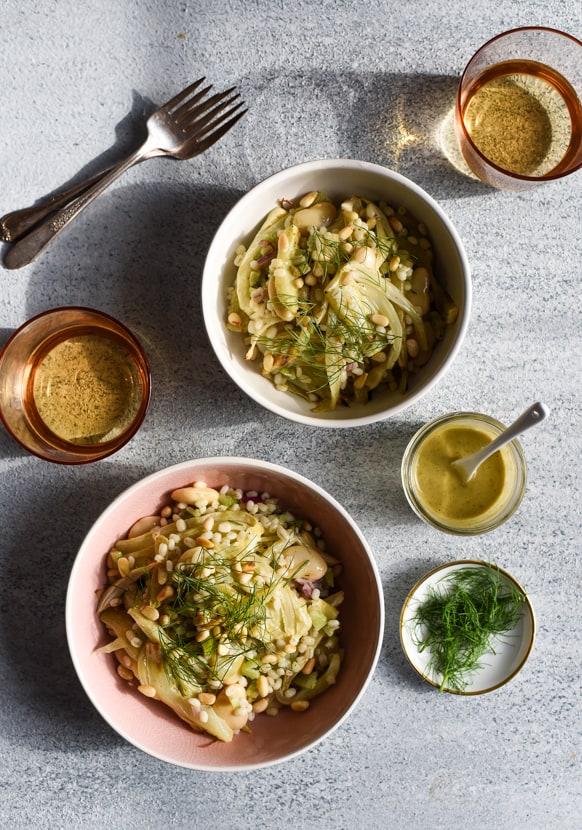
Here’s the thing about developing recipes for a blog versus for a book. With blog recipes, the time between coming up an idea and sharing it with the world can be a matter of days, hours, or even minutes. It’s nice to know that a blog recipe can be tweaked at any time if needed, or even erased entirely from digital existence. It puts less pressure on the recipe – it doesn’t really have to be perfect as it will soon be replaced by a new recipe on the homepage, and likely forgotten as time goes on by both the recipe developer and the reader.
Conversely, cookbooks are a slow, contemplative process. It starts with writing down ideas, curating them, getting them approved by an editor or a whole team of people, and then jumping into the deep sea known as Recipe Testing. The latter is a rigorous exercise of making, remaking, rethinking, and retesting again, until you are confident each recipe works as intended and is really yummy, too. This can force you into a vortex of obsessing over each ingredient, procedure step, and literally every other word on the page (which is actually quite fun for a perfectionist like me). So instead of simply writing and sharing an idea, a cookbook forces you to revisit the same set of ideas over and over again, to fall in love with each recipe, grooming and grooming it until it’s one-hundred percent ready to face the world and live in print forever. It’s mentally exhausting, but totally rewarding, too.
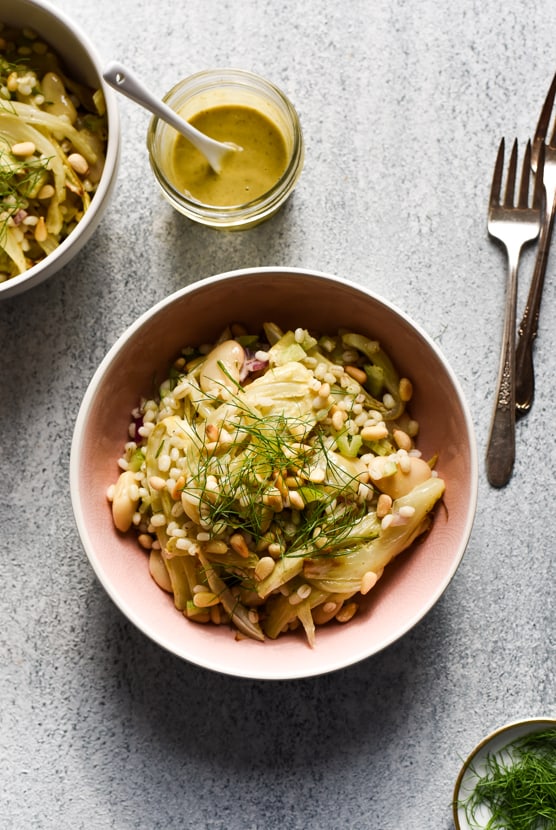
Though I can’t share all the details with you just yet, I can tell you that this cookbook concept took me out of my comfort zone. For the last two months, I’ve been working on more indulgent dishes than I’m used to – read: heavy on the meat and dairy – which while utterly delicious, have started to take their toll. After weeks of eating the results of these meaty and buttery recipe tests, I’ve really found myself craving my typical lighter fare – read: grains, legumes and vegetables.
This barley salad is an idea I’ve had written down for a while and finally had time to execute this weekend. Barley comes in two forms: hulled, which retains its bran and endosperm layers and can be considered a whole grain, and pearled, from which the bran and most of the endosperm have been polished off. Hulled barley has a tougher texture and takes longer to cook (similar to wheatberries), but it does retain more of its nutrients. Pearled barley (the kind most of us are used to eating in soups) has a lighter, softer texture, and is more fun to eat in my opinion. And while it’s not technically a whole food, pearled barley is still a great source of fiber, protein and iron.
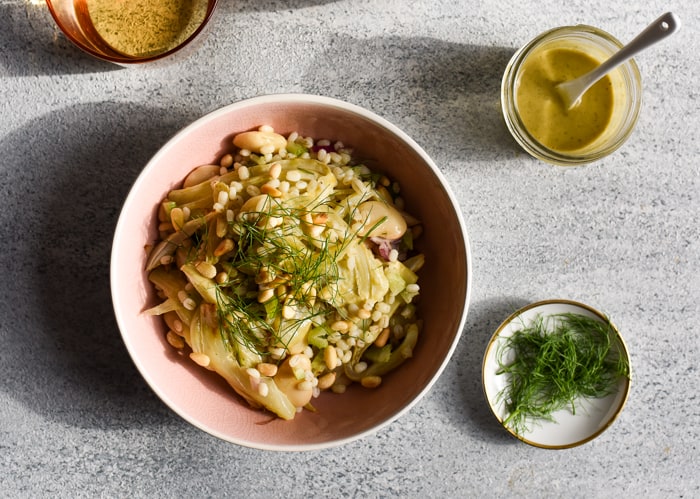
On to the fennel, a polarizing vegetable – people either love it or hate it. In its raw state, it’s crunchy, refreshing and has a light anise flavor. It gets sweeter as it cooks and the anise flavor mellows out. My favorite thing about fennel is that it comes with its own garnish! Fennel fronds are fluffy, beautiful, and kind of taste like dill.
This barley salad is a sophisticated take on the run-of-the-mill weekday grain bowl. You can prepare the salad and the dressing in advance and enjoy it throughout the week for lunch or dinner – just keep the salad and dressing separate until you’re ready to eat.
Print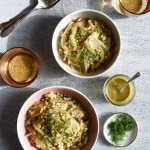
Barley Salad with Roasted Fennel, Butter Beans and Caper Vinaigrette
- Prep Time: 10 mins
- Cook Time: 30 mins
- Total Time: 40 minutes
- Yield: 4 servings 1x
- Category: Lunch, Dinner
- Cuisine: Vegan
Description
This barley salad is a sophisticated take on the run-of-the-mill weekday grain bowl.
Ingredients
- 1 cup pearled barley
- Fine sea salt and freshly ground black pepper, to taste
- 2 medium fennel bulbs, quartered and thinly sliced (stalks and fronds reserved)
- 3 tablespoons extra virgin olive oil, divided
- 2 tablespoons capers
- 2 tablespoons red or white wine vinegar
- 1 tablespoon Dijon mustard
- 1 tablespoon freshly squeezed lemon juice
- 1 tablespoon reserved fennel fronds, plus more to garnish
- 1 15-ounce can of butter beans, drained and rinsed
- 2 reserved fennel stalks, finely diced
- 3 tablespoons toasted pine nuts
- 2 tablespoons finely diced red onion
- 2 generous handfuls of white raisins
Instructions
- Place the barley into a medium pot and add enough cold water to cover by about 2 inches. Season with ½ teaspoon of salt, cover tightly with a lid, and bring to a boil. Reduce the heat to low and simmer with the lid ajar until barley is cooked through but still chewy, 20-25 minutes. Drain, rinse, and let come to room temperature before adding to the salad. (Note: To cool the barley faster, spread it in an even layer on a baking sheet after draining).
- Meanwhile, preheat the oven to 425F.
- Place the fennel on a parchment-lined baking sheet, drizzle with a tablespoon of oil, and season to taste with salt and pepper. Toss to coat and arrange in a single layer. Roast for 25-30 minutes, until the fennel is nicely browned in places, tossing once halfway through cooking.
- Meanwhile, in a blender, combine the capers, vinegar, mustard, lemon juice, fennel fronds, the remaining 2 tablespoons of oil, and a few turns of black pepper. Blend until smooth. Taste and adjust seasonings, if needed.
- In a large bowl, combine the barley, roasted fennel, beans, fennel stalks, pine nuts, onion, raisins, and dressing. Toss lightly to combine. To serve, garnish with fennel fronds.
Nutrition
- Calories: 460
- Fiber: 15.9 g
- Protein: 13 g
- Cholesterol: 0 g
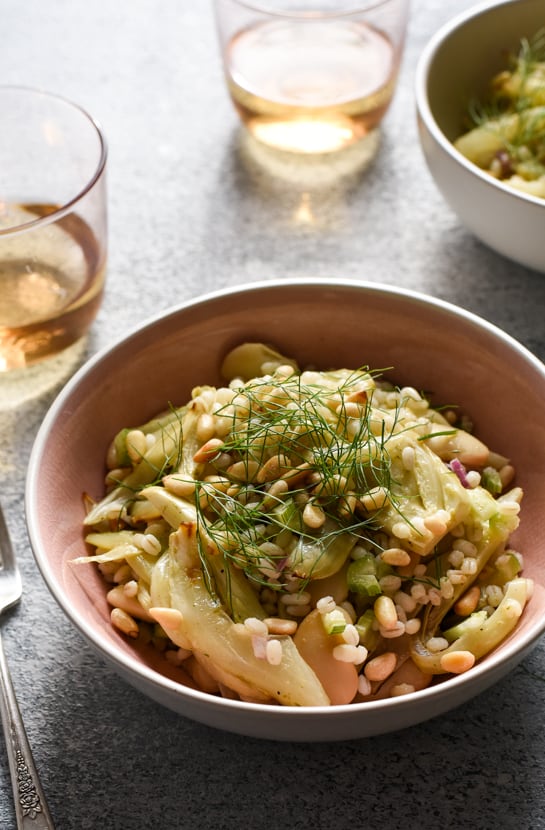
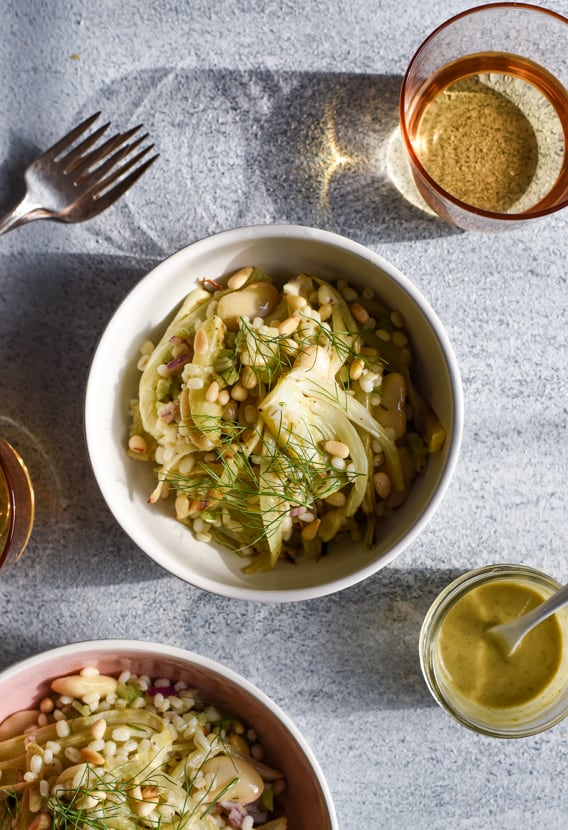

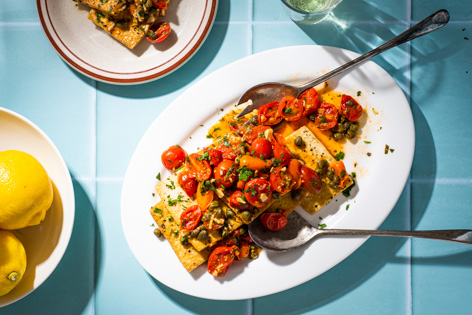
Melissa @ Insider The Kitchen says
Made it as your recipe for my family yesterday. We really really love it. Thanks!
Alexandra says
Yay! Thanks, Melissa 🙂
So glad you enjoyed it!
The Modern proper says
This looks great…perfect for spring.
Alexandra says
Thanks! Glad you like it 🙂